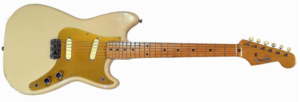Photo credit: Reverb.com
A short story: Through over twenty years of gripping my guitar neck like it had murdered my childhood dog (that is to say very tightly), I’ve caused damage to my fretting wrist that makes playing standard-scale guitars a challenge.
Oddly enough, I’ve had no issues with playing ukulele.
The issue mostly pops up when I play power chords, but the thing is I don’t really want to play anything else on the guitar. I love any other style on the ukulele (almost exclusively) except for rock where there’s just something… powerful about power chords that satisfies a primal part of my brain.
As an experiment, I went to Guitar Center and tried a Squier Mini Strat and that felt pretty great. I think the (ridiculously) short scale-length and small neck made for ludicrously comfortable playing.
So I did what any guitar nerd would: look for short-scale guitars of the vintage variety.
And, I should clarify before I go on, that when I say “short scale,” I mean REALLY short scale. Not Jaguar territory; smaller.
Turns out that Fender had a Duo-Sonic with a 22.5” scale until 1964 when they released a 24” scale as an option.
And Gibson released an ES-140 that not only featured a short scale, but a full depth for a jazz box and less of a… we’ll say toy-looking aesthetic. These were marketed as student models but were also played by pros on TV.
So they were a legitimate thing and then they weren’t a thing for some reason.
Personally, I blame banjo players because they’ve ruined so much in the guitar world. The 12-fret joint in acoustics turned into 14-fret joints with higher tones and greater tension because banjo players just had to have greater tension and more twang. Part of me thinks the shift from smaller guitars as an option to smaller guitars as an option for children just has to be because of banjo players.
Anyway, I’ve sort of fallen in love with these tiny guitars and plan on buying a couple in the future. The ES-140, for instance, nails that vintage jazz tone and the small neck would make for much easier handling of crazy chord shapes.
But then I started thinking that Ibanez’s Paul Gilbert Mikro (complete with faux f-holes!) would tick a lot of boxes for rock with its humbuckers and basswood body (hey! Just like an EVH Wolfgang!). Throw on some beefier tuners and your pickups of choice and it’s bound to be one of the most fun guitars in a collection.
And hey, we haven’t even mentioned acoustics, but that’s where things go a bit off the rails. Electric guitars – especially solid-bodies – have less variables or, at least, variables that have less of an impact. There’s just too much in the signal chain from pickups to pedals to amps (and their controls) for the fact that you’re playing a 3/4 guitar really matter.
Acoustics, meanwhile, have less ingredients and, therefore, more impact. Have you heard videos of the Little Martin? Look, I love Martin guitars, but the Little Martin honestly doesn’t sound very good. It’s more of an exercise in making a “travel,” guitar than making a small guitar that also sounds good.
But Ibanez is there for a player like me (again!) with the AE205JR and the AE245JR, both of which feature 23.9” scales and if they sound anything like some of the videos that have been posted on YouTube, they sound amazing.
Initially I was a little disappointed, though. While there are 3/4 offerings, they’re scant in supply, right? Where are the modern Duo-Sonics that have that awesome scale length? Where are Gibson’s ES-140s?
But then it hit me that I’m looking at this all wrong! Since 3/4 guitars are aimed at children and student players (of young ages), that means that they’re really aimed at parents who are on the fence about spending a lot of money on little Johnny or Susie’s initial request to learn guitar. They want a guitar that fits a beginning player’s small hands but also want to not spend a lot of money because they don’t know if the children are going to keep up with the instrument.
And the result? Low-cost instruments of varying quality! Squier’s mini-Strat is even listed with a body wood of “laminated hardwood.”
It seems that the bones of them are good, though. And besides: what do guitarists love more than modifying instruments? Popular mods include tuners, pickups, and some even get new nuts (for bigger strings) and people seem to be generally satisfied with them.
It makes you wonder why they aren’t more popular.
I mean, let’s consider this for a moment: They’re more affordable than most guitars, you can do some CRAZY stuff on them with chords and legato runs, they’re portable, modifiable, unique, and able. There’s less string tension which requires less pressure, and the necks are more manageable.
So where are the cons? I suppose there’s a lack of twang like you would find on a full-scale guitar. Some people have talked about “high,” tones, but I think if you have a Drop pedal, that problem is quickly fixed, too.
I will say a complaint I hear from people that holds water is that the fingerboard space gets cramped when you get into the high frets and shredding may be tough. It’s not a concern of mine, though as I’m too slow to play that high and spend most of my time north of the octave line.
It just seems like these are potentially underrated guitars that could possibly find a market if they were embraced more by the public. This would possibly increase the offerings.
But then that would also increase the prices companies can think they can charge…
Anyway, it was just a thought. Personally, I like the idea of small guitars. I’ll have to investigate this more in the future and get back to you all!
-Russ
